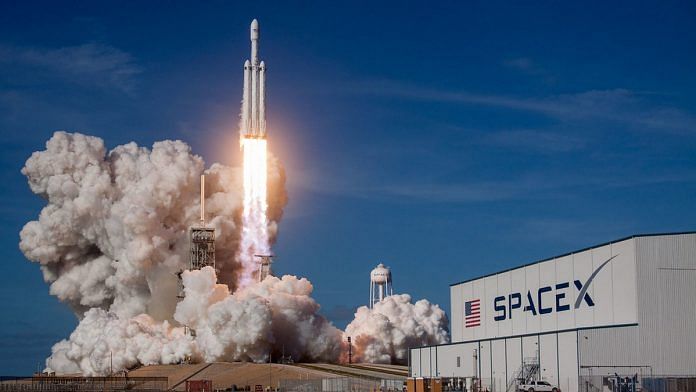The SpaceX Crew Dragon capsule that’s orbiting the Earth with two U.S. astronauts is the picture of New Space Age glamour. It’s a sleek, stylish commercially made capsule that’s destined to be featured beside Italian sports cars in future design textbooks. Just don’t tell that to Elon Musk, SpaceX’s chief executive and chief designer. “Is a Ferrari more reliable than a Toyota Corolla or a Honda Civic?” he once asked a space journalist. The answer, of course, is that the simpler sedans are far more reliable than the well-crafted sports car. So SpaceX, Musk made clear, was going to make Corollas.
It’s a practically minded outlook for a company founded on the galactically large ambition to transform humanity into a multiplanetary species. But Musk and SpaceX implicitly understand something that national space programs haven’t really accepted: Success in space exploration isn’t, ultimately, about achieving “firsts” like the moon landing. Rather, it’s repeat business that will establish moon colonies and Musk’s Martian city. To get that business, SpaceX has to show that national space programs, with their expensive, Ferrari-like rockets, capsules and contractors, won’t get there. On Saturday, it succeeded.
The 20th century space race wasn’t about the money, it was about the record books. The respective financial strengths of the U.S. and Soviet systems certainly played a role, but when national pride is at stake, performance matters more than costs. For decades, NASA, in particular, internalized that priority by adopting cost-plus contracts with its contractors. Under these arrangements, NASA agrees to pay the value of a project’s development costs, plus an associated fee (often about 10%). It’s an excellent system for encouraging contractors to invest in difficult, long-term projects with hazy costs.
But if the goal is to create something that works repeatedly, and on-budget, cost-plus is a problem. After all, if a contractor’s fees increase during project delays, then that contractor lacks an incentive to control costs and finish on deadline. Making matters more difficult, expensive government programs must meet political requirements that no profit-seeking business would ever consider. The development of the 1970s-era space shuttle was spread out over states and produced an outrageously expensive “reusable” rocket that took thousands of hours to prepare for reuse. In 2012, Musk correctly called the shuttle “a Ferrari to the nth power.”
By that point, Musk, too, was working with the U.S. government. But unlike traditional NASA contractors such as the Boeing Co, he was doing it on a fixed-fee basis. So, rather than get paid along the way, SpaceX accepted a fixed fee to build a technology, and whatever wasn’t used in development could be kept as profit.
That doesn’t mean cutting corners. NASA requires that SpaceX’s technology meet its high safety standards (often to Musk’s chagrin). But it does mean that SpaceX has a strong incentive to find ways to control costs while building cutting-edge technology. For example, rather than try to perfect a single rocket for a flawless first launch, SpaceX opted for iterative design, whereby it launched — and failed — early prototypes repeatedly, as a means to learn from its mistakes and speed up rocket design. It’s an approach that differs substantially from traditional aerospace companies, which spend years and money perfecting a design before flying it (the Ferrari approach). Likewise, SpaceX, freed from political constraints, concentrated its design and testing in single locations, rather than spread it out geographically. It’s what any rational for-profit manufacturer would do.
This approach has been fruitful. The rocket that carried the Crew Dragon capsule into orbit is a Falcon 9, from a family of rockets developed for $390 million with assistance from NASA under fixed-price contracts. According to a 2011 NASA report, the cost would’ve been $1.7 billion to $4 billion if the same rocket had been developed using traditional means. More dramatically, the development of the Falcon 9 has reduced the cost of a space launch by a factor of 20, at least. A kilogram launched on the space shuttle, which last flew in 2011, cost about $54,500. A kilogram on the Falcon 9 runs about $2,700.
Of course, launching humans into space is more difficult and expensive than launching cargo. Even so, SpaceX managed to lap more traditional contractors. In 2011, NASA announced plans to build the Space Launch System, a massive new rocket to send Americans back to the moon. To save on costs and time, the rocket was to be built using engines and other components from the space shuttle program. Ominously, it was also to be built by the Boeing Co under a cost-plus contract. In 2014, NASA committed to a November 2018 launch date at a cost of $9.7 billion. Then the launch dates started slipping, all to the benefit of Boeing. By March, the launch date had moved to the second half of 2021, with costs escalating to $18.3 billion. If and when it flies, each rocket will exceed $1 billion — more than three times what it cost to develop the Falcon 9.
For now, SpaceX’s approach is the clear winner, but its challenges are far from over. Above all, the company must demonstrate that its relatively inexpensive human-capable flights have a commercial market — an idea that’s far from certain. Similarly, the company will need to prove the business case for its longer-term, and substantially more expensive, ambitious exploration program. But today, at least, the Musk’s Corolla is beating the Ferrari by millions of miles. – Bloomberg
Also read: Elon Musk’s SpaceX launch with astronauts today will make space business really serious






